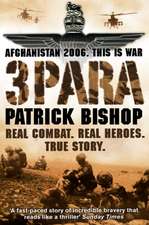The European Union Since 1945: Seminar Studies
Autor Alasdair Blairen Limba Engleză Paperback – 8 iul 2010
In this fully updated new edition, Alasdair Blair examines the economic, political, social and personal factors that have shaped the process of European integration from the end of the Second World War until the Lisbon Treaty in 2009. Written in a clear and jargon-free style, the book explores:
- The context of European integration and expansion
- The relations between the European Union and its member states
- The institutional evolution of the European Union
- Methods of decision-making
- Key policies of the European Union
- The future direction of the European Union
Comprehensive and accessible, this book is an essential guide to understanding the relevance of the European Union in the twenty-first century.
Din seria Seminar Studies
-
 Preț: 305.61 lei
Preț: 305.61 lei -
 Preț: 394.47 lei
Preț: 394.47 lei -
 Preț: 193.64 lei
Preț: 193.64 lei -
 Preț: 322.38 lei
Preț: 322.38 lei -
 Preț: 211.76 lei
Preț: 211.76 lei -
 Preț: 308.30 lei
Preț: 308.30 lei -
 Preț: 307.26 lei
Preț: 307.26 lei -
 Preț: 307.80 lei
Preț: 307.80 lei -
 Preț: 314.14 lei
Preț: 314.14 lei -
 Preț: 309.39 lei
Preț: 309.39 lei -
 Preț: 309.39 lei
Preț: 309.39 lei -
 Preț: 330.52 lei
Preț: 330.52 lei -
 Preț: 305.63 lei
Preț: 305.63 lei -
 Preț: 314.50 lei
Preț: 314.50 lei -
 Preț: 316.72 lei
Preț: 316.72 lei -
 Preț: 307.65 lei
Preț: 307.65 lei -
 Preț: 308.52 lei
Preț: 308.52 lei -
 Preț: 307.27 lei
Preț: 307.27 lei -
 Preț: 299.85 lei
Preț: 299.85 lei -
 Preț: 314.14 lei
Preț: 314.14 lei -
 Preț: 306.94 lei
Preț: 306.94 lei -
 Preț: 314.42 lei
Preț: 314.42 lei -
 Preț: 402.80 lei
Preț: 402.80 lei -
 Preț: 305.90 lei
Preț: 305.90 lei -
 Preț: 346.51 lei
Preț: 346.51 lei -
 Preț: 310.45 lei
Preț: 310.45 lei -
 Preț: 306.00 lei
Preț: 306.00 lei -
 Preț: 306.39 lei
Preț: 306.39 lei -
 Preț: 306.39 lei
Preț: 306.39 lei -
 Preț: 349.57 lei
Preț: 349.57 lei -
 Preț: 306.06 lei
Preț: 306.06 lei -
 Preț: 304.42 lei
Preț: 304.42 lei -
 Preț: 314.03 lei
Preț: 314.03 lei -
 Preț: 332.21 lei
Preț: 332.21 lei -
 Preț: 306.29 lei
Preț: 306.29 lei -
 Preț: 308.52 lei
Preț: 308.52 lei -
 Preț: 204.23 lei
Preț: 204.23 lei -
 Preț: 307.93 lei
Preț: 307.93 lei -
 Preț: 306.29 lei
Preț: 306.29 lei -
 Preț: 427.54 lei
Preț: 427.54 lei -
 Preț: 316.55 lei
Preț: 316.55 lei -
 Preț: 330.10 lei
Preț: 330.10 lei -
 Preț: 266.29 lei
Preț: 266.29 lei -
 Preț: 305.47 lei
Preț: 305.47 lei -
 Preț: 348.97 lei
Preț: 348.97 lei -
 Preț: 308.91 lei
Preț: 308.91 lei -
 Preț: 308.03 lei
Preț: 308.03 lei -
 Preț: 307.93 lei
Preț: 307.93 lei -
 Preț: 305.97 lei
Preț: 305.97 lei -
 Preț: 305.90 lei
Preț: 305.90 lei
Preț: 137.33 lei
Nou
Puncte Express: 206
Preț estimativ în valută:
26.28€ • 27.44$ • 21.75£
26.28€ • 27.44$ • 21.75£
Carte tipărită la comandă
Livrare economică 05-19 aprilie
Preluare comenzi: 021 569.72.76
Specificații
ISBN-13: 9781408234525
ISBN-10: 1408234521
Pagini: 224
Dimensiuni: 170 x 240 x 15 mm
Greutate: 0.1 kg
Ediția:Revizuită
Editura: Taylor & Francis
Colecția Routledge
Seria Seminar Studies
Locul publicării:Oxford, United Kingdom
ISBN-10: 1408234521
Pagini: 224
Dimensiuni: 170 x 240 x 15 mm
Greutate: 0.1 kg
Ediția:Revizuită
Editura: Taylor & Francis
Colecția Routledge
Seria Seminar Studies
Locul publicării:Oxford, United Kingdom
Cuprins
Publisher’s acknowledgements
Author's acknowledgements
Preface to the Second Edition
Abbreviations
Chronology
Who’s Who
Glossary
Maps
PART ONE: BACKGROUND
1. THE PROBLEM OF EUROPEAN INTEGRATION
PART TWO: ANALYSIS
2. THE ROAD TO ROME: 1945–57
The Emergence of European Unity
The Hague Congress
The Coal and Steel Community
The Failure of the European Defence Community
3. CONSTRUCTING THE COMMUNITY: 1958–70
Institutional Design
Policies and Competencies
The Nationalist Backlash
The Spirit of the Hague
4. THE ENLARGED COMMUNITY: 1970-84
The First Enlargement
Britain’s Indecision
Eurosclerosis
Transatlantic Difficulties
Britain’s Budgetary Question
5. THE TRANSFORMATION OF EUROPE: 1985-1993
Creating the Internal Market
The Single European Act
The Road to 1992
Europe’s Changing Map
The Maastricht Treaty
6. BUILDING A NEW EUROPE: 1994-201nbsp;
Enlarging the EU
Treaty of Amsterdam
Treaty of Nice
The Fifth Enlargement and Constitutional Reform
Lisbon and Beyond
PART THREE: ASSESSMENT
7. THE FUTURE OF EUROPEAN INTEGRATION
Boundaries of Europe
Nature of membership
The future of European integration
PART FOUR: DOCUMENTS
Further reading
References
Index
Recenzii
“The European Union Since 1945 should be read by undergraduates in introductory EU courses, policy practitioners who are interested in how the European project developed over time, and by the intelligent general reader. This is an excellent example of how an accessible textbook with crucial supporting documents should be written, documented and presented.”
Neil Winn, European Foreign Affairs Review
“...The most concise and accurate description of the development of European institutions and their policies.”
Michael J. Steffens, Political Studies Review
“The author is balanced in his presentation of the controversies surrounding the organisation and its future.”
Dr James Munson, Contemporary Review
Neil Winn, European Foreign Affairs Review
“...The most concise and accurate description of the development of European institutions and their policies.”
Michael J. Steffens, Political Studies Review
“The author is balanced in his presentation of the controversies surrounding the organisation and its future.”
Dr James Munson, Contemporary Review
Descriere
The European Union since 1945 provides a general survey of European integration, from its emergence at the end of World War II to 2010, including the negotiation of the Constitutional Treaty in 2004, the Lisbon Treaty of 2007, and subsequent enlargements. Adopting a chronological approach, the book examines the economic and political factors that have shaped the process of European Integration, and as a consequence the transfer of power away from member states.
Written in a clear, jargon-free and accessible style, the book explores the problem of European integration and expansion, the relationship between the European Union and its member states, its institutional evolution, methods of decision making, key policies and what direction it will take in the future.
Suitable for undergraduate courses on the EU taken as part of the European Studies, History, Politics, International Relations or Law degree.
Written in a clear, jargon-free and accessible style, the book explores the problem of European integration and expansion, the relationship between the European Union and its member states, its institutional evolution, methods of decision making, key policies and what direction it will take in the future.
Suitable for undergraduate courses on the EU taken as part of the European Studies, History, Politics, International Relations or Law degree.















